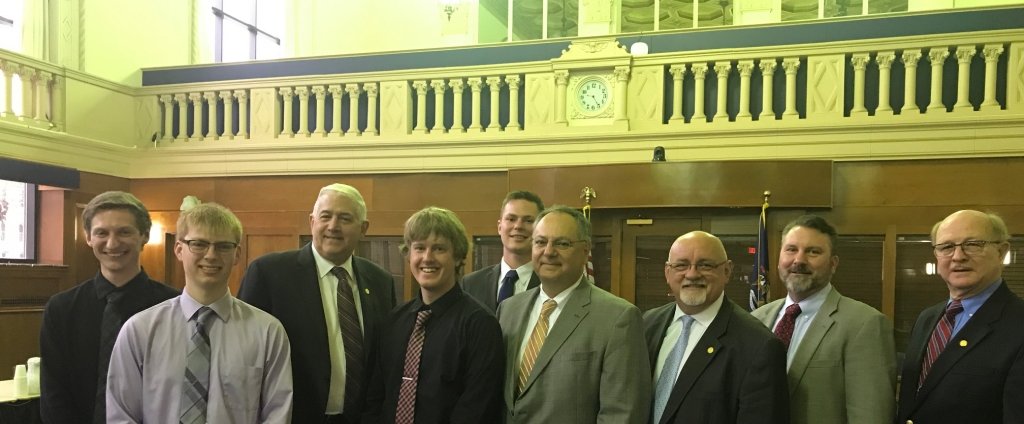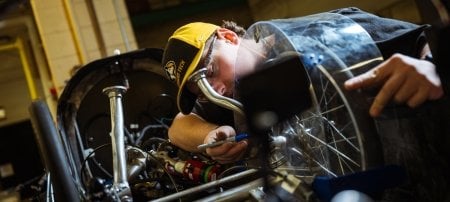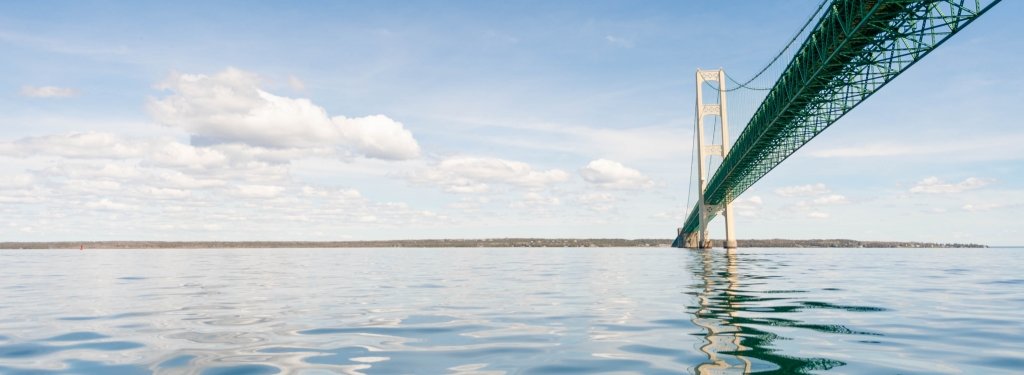Hundreds of 2018 Michigan Technological University graduates started new jobs this week. Four of them took a detour to the State Capitol to share their Senior Design project—an underwater utility corridor spanning the Straits of Mackinac—with Michigan lawmakers.
The corridor, a 21-foot-diameter, 4.5-mile tunnel that would house utility lines that cross the Straits, was this year's senior capstone project for 13 civil engineering and three construction management graduates. The four students representing the group presented the project to the state's 15-member Pipeline Safety Advisory Board at its quarterly meeting on Monday morning. They made a second presentation, to the joint meeting of the Senate Committee on Transportation and the House Transportation and Infrastructure Committee, at the Michigan State Capitol in Lansing on Tuesday morning. Officials were impressed by both the concept and the students.
"I thought it important the Legislature hear that there are real alternatives for spanning the Straits with the utilities that are critical to the well-being of the Upper Peninsula—alternatives that are environmentally safe and may be economically viable," said Senate Transportation Chair Tom Casperson, R-Escanaba, whose home district encompasses the UP. "I was all the more eager that the Legislature be made aware of these findings to showcase why Michigan Tech is renowned throughout the world for the exceptional quality of the education it offers students—quality that was evident to my colleagues through the detailed, thorough, thoughtful and articulate analysis students presented."
Senator Ken Horn, R-Frankenmuth, transportation committee vice chair and acting chair for Tuesday's session, said he's intrigued by the design concept. “Michigan is capable of managing very big projects and our economic and environmental future looks bright if this concept can become a reality. The students from Michigan Tech prove, once again, that some of the world's smartest people are Michiganders.”

Tech grads, with industry advisor Jim Morrison, present their findings at the State Capitol. (Senate Communications photo)
Prast says the pipeline advisory board had questions about the team's design and depth of research, and were struck by the relevance of the project. "One of the questions that wasn’t technical that stood out was, 'What is the part of the project that scares you the most?'," says Prast. "Aaron accurately replied, 'Getting four different utility companies to work together and cohabitate this utility tunnel.'"
The Line 5 pipeline garners the headlines. But it's one of many utilities that cross the Straits, the wind-and-current-complicated body of water between Great Lakes Michigan and Huron spanning Michigan's Lower and Upper Peninsulas. Phone, natural gas and electrical lines could be housed in the tunnel, accessed by a non-emitting electric locomotive-style vehicle. In an emergency, the tunnel portal and the tunnel itself are designed to accommodate a conventional vehicle. The team's design encompasses existing utilities currently running across the Straits and leaves room for future expansion.
Capping Off a Michigan Tech Education
Senior Design projects at Michigan Tech, also known as capstones, are treated more like a first job than a final course. Civil engineering and construction management capstone advisor Mike Drewyor, a professor of practice in the School of Technology and the Civil and Environmental Engineering Department, required students to turn in timesheets and wade through red tape, like Freedom of Information Act (FOIA) requests and the permitting process required to site and construct a tunnel. Students work directly with industry advisors.
"The idea is to quit thinking like a student and start thinking like an engineer," says Drewyor. Students have worked on major pieces of important projects over the years. This year is especially memorable, though. "We couldn't have picked a project more timely or interesting," he says.
"It felt like we were truly working on a project, not just to fill a class credit, but also to contribute to society and add a solution to a very real and contested problem."
Tunnel Vision

Michigan Tech students worked in four teams of four, each operating under the direction of Drewyor and engineering consultant Jim Morrison, the fellow Michigan Tech alumnus who came up with the idea for the project.
- The UP Precision team handled everything above ground, including property, easements and facilities.
- The Horizons team addressed geology, from studying bedrock borings from Mackinac Bridge construction to current core samples. "These students aren't geologists. They learned a lot," says Drewyor.
- The Tunnel X team optimized a tunnel cross-section, designing safety, ventilation, lighting, electrical and communications and vehicle access.
- The Made Consultants team investigated vertical shafts, elevators and stairs before designing an entry portal to provide optimal access.
A tunnel proposal isn't new—the State previously considered a smaller diameter corridor, which prompted Morrison and the group to explore the possibilities of a larger, more adaptable infrastructure. The advantages of the student-designed concept: easy access in a single corridor that can be controlled, shielded and contained in the event of an accident.
The group worked together on an overall schedule and budget summary. The estimated construction price tag is $570 million, excluding overhead like engineering and permitting costs.
Big ideas for a one-semester project. Much remains to be studied, but the hope is that the presentation opens up constructive dialogue about possibilities. Drewyor says students learn to look at projects objectively; pros and cons are part of the analysis. "Engineering is always a choice among alternatives. You need to explore all the alternatives."
Prast says controversy didn't factor into the group's presentation or work. "We were not there to pick a side, but instead to present an alternative to the well-known issue of pipelines, not just Line 5 leaking into the Straits."
In January 2018, the State hired Michigan Tech to lead state universities in an independent
risk analysis of the Line 5 Straits Pipelines. The project is directed by Guy Meadows,
Robbins Professor of Sustainable Marine Engineering and director of the Great Lakes
Research Center at Michigan Tech. The capstone project is not related to this endeavor.
Michigan Technological University is an R1 public research university founded in 1885 in Houghton, and is home to nearly 7,500 students from more than 60 countries around the world. Consistently ranked among the best universities in the country for return on investment, Michigan's flagship technological university offers more than 185 undergraduate and graduate degree programs in science and technology, engineering, computing, forestry, business, health professions, humanities, mathematics, social sciences, and the arts. The rural campus is situated just miles from Lake Superior in Michigan's Upper Peninsula, offering year-round opportunities for outdoor adventure.







Comments